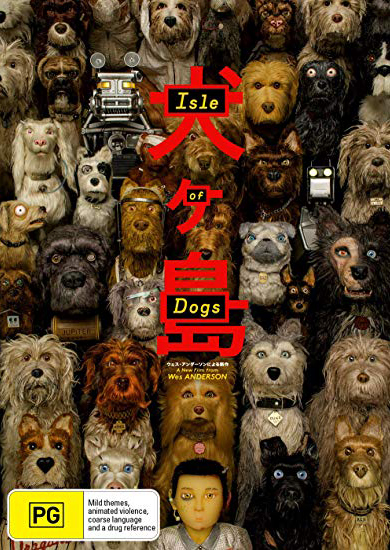Isle of Dogs
Animation which follows a boy's search for his lost dog in futuristic Japan. Character-driven comedy with a melancholic and satirical undertone as expected from a Wes Anderson film.
Film Notes
Isle of Dogs review – Wes Anderson's scintillating stop-motion has bite
4/5stars out of 5 stars.
Marooning a pack of dogs on a dystopian Japanese island, the auteur’s new animation is an inspiringly detailed and surprisingly rough-edged treat.
It’s well known that for Wes Anderson, the world is one big toy box. The prodigious American auteur proved that with his last feature, The Grand Budapest Hotel, which turned its human cast into comic puppets placed in a gorgeously crafted train-set universe. Now he proves it again – if anything, more extravagantly – with Isle of Dogs, an animation which, like its predecessor, opens the Berlin film festival in scintillating style.
Anderson has tried his hand at stop-motion animation before with the Roald Dahl adaptation Fantastic Mr Fox, but this new talking-animal entertainment is considerably more sophisticated and ambitious. It’s set in a near-future Japan, where Kobayashi (voiced by Kunichi Nomura, one of the film’s co-writers), the corrupt mayor of fictional city Megasaki, has taken draconian measures to curb the spread of various canine diseases, including the dreaded “snout fever”. He orders all Megasaki’s dogs to be exiled to a bleak island, essentially a huge offshore trashpile.
Life there looks hopeless for its exiles until they get a visit from Kobayashi’s intrepid 12-year-old ward Atari (Koyu Rankin), in search of his beloved, long-lost Spots. A band of mutts led by battle-scarred stray Chief (Bryan Cranston) help Atari on his mission, which involves exploring the scarier parts of the island, a mix of industrial wasteland and abandoned funfair, with fully functioning mechanised parts. Meanwhile, a pro-dog student group – including moppet-like American visitor Tracy (Greta Gerwig) – are rising up against Kobayashi, with the help of research scientist Yoko Ono (voiced by Yoko Ono).
Visually and thematically, Isle of Dogs is steeped in contemporary Japanese pop culture and futuristic iconography, but it also draws on traditional influences – not least in its witty allusions to Hokusai and other classic art. The result could have come across as shameless cultural tourism, but the film suggests real immersion in Japanese culture and cinema, with Akira Kurosawa’s epics an avowed model. Anderson also plays his linguistic hand subtly and wittily, leaving the Japanese dialogue largely untranslated rather than cater too obviously to the western audience.
Meanwhile, the dogs’ dialogue is performed in English by assorted western stars, including Anderson alumni Bill Murray and Tilda Swinton, along with Jeff Goldblum as the gossip-loving Duke. Scarlett Johansson also voices Nutmeg, a former show dog who’s tougher than her silky fur suggests. She is Chief’s opposite number in a tentative Lady and the Tramp courtship, but their banter has a hardboiled edge of Bogart and Bacall.
The puppet dogs’ expressive eyes may occasionally well up with tears, but if there’s one thing that Isle of Dogs isn’t, it’s twee; Anderson and his story collaborators, who also include Roman Coppola and Jason Schwartzman, firmly eschew the Japanese cult of kawaii, or cuteness. Visually, the styling favours the rough-edged – plenty of scabs, ripped ears and torn fur. Shot at London’s 3 Mills Studios and Berlin’s Babelsberg, the film – which also includes some traditional hand-drawn cartooning - is a breakneck succession of dazzlingly executed sight gags, including tooth-and-claw fights shrouded in thick cotton wool clouds. The character design is brilliant, too – although not all the dogs emerge as individuals, and the laidback dialogue style means that the voices don’t always differentiate them that much.
Still, the production design is consistently inspired and often quite beautiful: rippling glittery seas, a line of elongated doggie shadows marching along a wall of garbage, a multi-coloured hideout made of discarded sake bottles. There is so much detail in the breakneck race from image to image that Isle of Dogs will reward multiple viewings as much as any Anderson film, visually if not narratively. Alexandre Desplat’s minimalist score is also a pleasure, mixing taiko drumming, laconic jazz bass and the occasional dash of Prokofiev.
As with much of the director’s work, you shouldn’t expect a huge emotional payoff, and the one-liners are often as dry as Bonio. But this hugely enjoyable package shows an indefatigably fertile imagination letting rip in inimitable style – and packing an eco-themed, antibigotry message as well. You can rest assured, Anderson ain’t selling us no pup.
Jonathan Romney, The Guardian
Isle of Dogs review: if you're looking for cute, cuddly Wes Anderson you're barking up the wrong tree
Everything you might expect to be cute, charming and generally edible about a canine-themed Wes Anderson stop-motion animation is spectacularly upended, then poured into a landfill, during Isle of Dogs. This is by some measure Anderson’s weirdest concoction ever, in all sorts of good ways. And it probably counts as his most daring, too.
The premise hardly hides all this away. It’s about a diseased community of unwanted mutts, dumped on a trash island off the coast of a dystopian future Japan. Voiced by the likes of Bryan Cranston, Jeff Goldblum, Bill Murray and Edward Norton, these dogs do not play nice and definitely don’t smell nice. When we first meet them, they’re lamenting their predicament as outcasts from human society – ejected by the dog-hating authorities after an epidemic of canine flu – and tussling over a sack of maggot-infested food which drops from the sky.
Amid this fracas, which Anderson times to comic perfection, Cranston’s Chief tears another dog’s ear off with his teeth, spits it out, and gently kicks it away, where it’s promptly gnawed upon by starving rats. Later, all the precision and detail of Anderson’s top-flight modelling team are set to work on showing us an anatomically perfect (human) kidney transplant. This is not a Wes Anderson film for the Best Exotic crowd, be very sure of that.
Watching Anderson go this dark might take some viewers aback, but there’s remarkable beauty and a sober delight to his vision of creatures scrabbling for survival. He has emphasised his debt to the Japanese maestro Akira Kurosawa with this whole idea, and while the quest in the story, to find a missing guard dog called Spots, recalls some of that director’s samurai films, the setting is very specifically indebted to Dodes’ka-den, his multi-strand 1970 drama about people subsisting atop a rubbish heap. It’s Dog-des’ka-den! You heard it here first.
The allusions to all that stuff are worn lightly enough to be ingenious background. But the film’s graphic detailing, even by Anderson’s standards, is an ever-replenishing smorgasbord, an embarrassment of riches from beginning to end. Japan, 20 years hence, is coded crimson-red as a diabolical tyranny, with Orwellian posters scowling down everywhere depicting Mayor Kobayashi (Kunichi Nomura, a co-screenwriter also), the dog-phobic, cat-stroking despot perhaps responsible for spreading the disease in the first place. His son Atari (Koyu Rankin), a rogue pilot, is the one looking for Spots, the redoubtable pet snatched from him and known as “dog zero” for being the first one dumped on Trash Island.
During this flashback-heavy exposition, Anderson throws us one still image of imperilled dogs cast out to sea, instantly recognisable as a superb pastiche of Hokusai’s The Great Wave off Hanagawa, and by no means the last time the great Edo printmaker inspires an image or a mood here.
The leaning on archetypes, some of them questionable, and stylisation across a whole range of Japanese artforms, are manoeuvres certain to get Anderson in hot water once the film is more widely seen, just as The Darjeeling Limited – a much more vacuously touristy exercise – was accused of mishandling race.
But listen! Alexandre Desplat’s score, which might be peak Desplat for overall invention, is busy at work being a brilliant synergy of Western and Eastern musical forms. With its battery of taiko drums rattling away ominously, but also a fluty, buoyant finale, it suggests a missing link between Toru Takemitsu (Dodes’ka-den’s legendary composer) and the entirely non-Japanese Henry Mancini. Plus the score adapts – sorry, culturally appropriates – Prokofiev’s Troika from Lieutenant Kije and makes this fit just as well.
Individually, the voice cast have less do to here than they did in Fantastic Mr Fox – there are more characters to divide the lines between – but most get moments to relish. Harvey Keitel nearly steals the honours with a heartsore, one-scene cameo as the head of a rumoured cannibal clan.
Scarlett Johansson’s role as a show dog/love interest called Nutmeg, who bears a strange resemblance in grooming and deportment to Lee Remick, is off to the side – more so than Greta Gerwig’s feisty, thatch-haired student protester, busy speaking truth to power on mainland Japan while being, a little inexplicably, white.
A buried treat awaits in the end scroll, with Anjelica Huston credited as “mute poodle”. And this makes you realise something: for all the eccentric repartee Anderson and his screenwriters have whipped up, the film is generally at its best when the dogs aren’t talking. Few moments beat the apprehensive eye movements of Spots near the start, when he’s transported by cage across land and sea to become the island’s first dismal resident.
And nothing’s funnier than the fights, furious flurries of dust and doggy limbs, like old Hanna-Barbera set pieces spun out of control. When Atari and Chief are separated from their posse and must push on into the sunset, there are just a few beats of quiet downtime, but they’re as visually magical as anything Anderson has ever dreamed up.
The film flirts with grotesquerie and even shocks with its late-breaking gambits. For once, in tone and in habitat, he has well and truly exited his comfort zone.
Tim Robey, The Telegraph,
What you thought about Isle of Dogs
Film Responses
| Excellent | Good | Average | Poor | Very Poor |
|---|---|---|---|---|
| 27 (57%) | 13 (28%) | 4 (9%) | 2 (4%) | 1 (2%) |
|
Total Number of Responses: 47 Film Score (0-5): 4.34 |
||||
Collated Response Comments
109 members and guests attended with 47 responses giving a hit rate of 43%.
“A very enjoyable evening! A clever film able to be read in different ways… face value a great story of friends, loyalty and comradeship...or maybe an allegory highlighting corruption, oppression & prejudice! Either way a five from me. The bento box scene was superb!”
“Loved it – my previous antipathy to Wes Anderson all reversed. Light but engrossing story, beautifully animated. Baddies and goodies clearly delineated but a sense that, underneath everything is a serious allegory”. “One of those films that makes you wonder what on earth possesses someone to come up with a storyline like that! Original and entertaining with a good sense of humour. Very enjoyable. Thanks”.
“Brilliant from start to finish. Graphics, sets, soundtrack, voices – all outstanding. A wonderful film”. “Love a happy ending”. “Cute in a Wes Anderson-ish way, but with plenty of meat to think about. Lovely animation/sound connections”.
“Did wonder if this film would be more enjoyable than Anderson's 'Fantastic Mr Fox' – and it was. Thought that the detail in many of the set scenes were more than a nod to Kurosawa and Mifune, as well as the recent developments of Japanese animation films. Then sensed hints at other film makers (shots of huge audiences like Riefenstahl's 'Triumph of the Will'). Wondered why a wasteland looked almost beautiful and how Anderson had made these scruffy, mangy pooches so engaging. Narrative was simple; good (of sorts) v evil; the obvious parallels with today's society, which seems keen on segregation, with the dogs being banished. Liked its eccentric nature and the dogs themselves messy fur and characterful eyes, staring quizzically at the camera”.
“Stunningly original film making. A feast for all the senses. Quite brilliant”. “Unexpectedly amusing. Hugely entertaining. Detail of the animation was exceptional”.
“Very clever, Loved the dogs voices. Very witty”. “Great imagination – really sympathised with a cartoon character”. “Loved the facial expressions. Also Trash Island is eye opening. I believe something like this really exists – we just don’t see it and don’t talk about it”. “Fantastic. Good comedy – very clever – so sharp. Loved it. Quite a roller coaster of a journey”. “Brilliant, funny, imaginative”. “Very amusing and clever”. “Amusing – thought-provoking and great animation”. “Amazing cinematography. Engaging and thought-provoking”. “Brilliant”. “”Especially having been a dog owner for 30 years”. “Brilliant, original moving satire and modern fairy tale. Creative, original and full of emotional intelligence. A new Eco-drama genre”. “Lovingly put together and funny”. “Brilliant. First time heard so much laughter at a cartoon. Wonderful, innovative execution”. “Entertaining”.
“Fascinating technically. Some of it a bit obscure! But lovely witty passages”. “Way beyond me, I’m afraid, I didn’t follow what was going on. It seemed to me rather like a doggy Simpsons doing Lord of the Rings, or Venezuela, or Brexit. Perhaps it would help if (a) one likes dogs and (b) one appreciates animation. Score based on subjective view!”
“Loved the drumming! The dog’s expressions were brilliant. The fights were very expressive”. “Quite funny. Not sure what the message was!” “Very different”. “Original, slightly crazy, surprisingly enjoyable”. “Brilliant animation! A bit Animal Farmish – quite poignant in places”. “Adore Wes Anderson films but this was not one of his best – not such a light touch as usual”. “An allegory on exile and persecution, but once that was established it was rather predictable. Why was it a white American was needed to challenge the elite. White saviour syndrome? Loved the soundtrack”. Curious and occasionally charming, but a ridiculous and tedious self-indulgence”. “Biggest load of rubbish I have seen”.



